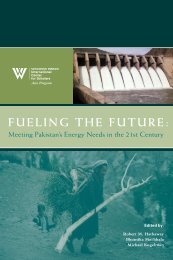Environmental Change and Security Project Report - Woodrow ...
Environmental Change and Security Project Report - Woodrow ...
Environmental Change and Security Project Report - Woodrow ...
Create successful ePaper yourself
Turn your PDF publications into a flip-book with our unique Google optimized e-Paper software.
COMMENTARY • The Next Steps for<br />
Environment, Population, <strong>and</strong> <strong>Security</strong><br />
From <strong>Environmental</strong> Peacemaking to<br />
<strong>Environmental</strong> Peacekeeping<br />
Nowhere is the notion that water causes<br />
conflict more widespread than in<br />
the Middle East. Former Secretary<br />
General of the United Nations Boutros<br />
Boutros Ghali warned in 1985, “The next war<br />
in the Middle East will be fought over water,<br />
not politics” (Vesilind, 1993, page 53). More<br />
than any other environmental resource, water<br />
is used to bolster claims that environmental<br />
degradation <strong>and</strong> resource scarcity produce conflict<br />
(e.g., Homer-Dixon, 1994). 1 Over the last<br />
few decades, scholars have sought to identify<br />
how competition over fresh water leads to<br />
interstate conflict (Gleick, 1993; Ohlsson,<br />
1995; Elhance, 1999).<br />
The emphasis on conflict, however, has overshadowed<br />
the less provocative—but no less<br />
major—premise that water is more likely to<br />
induce cooperation than conflict, even in arid<br />
regions with scarce or unevenly distributed<br />
freshwater supplies (Wolf, 1998). For example,<br />
contrary to predictions that water might spark<br />
interstate conflict in post-Soviet Central Asia<br />
(Panarin, 1994; Smith, 1995), water motivated<br />
cooperation among the five newly independent<br />
states of Kyrgyzstan, Kazakhstan, Tajikistan,<br />
Turkmenistan, <strong>and</strong> Uzbekistan (Weinthal,<br />
2002). And despite all the hype about the<br />
Middle East’s incipient water wars (Gleick,<br />
1994; Starr, 1991), Israeli <strong>and</strong> Palestinian water<br />
managers continued to cooperate—even as<br />
other forms of economic <strong>and</strong> security cooperation<br />
collapsed—after the second intifada began<br />
in 2000 (Rinat, 2001).<br />
While conflict <strong>and</strong> violence still dominate the<br />
environmental security discourse, new research<br />
focusing on environmental peacemaking has<br />
challenged the assumed link to conflict. Conca<br />
& Dabelko (2002) suggest, “<strong>Environmental</strong><br />
cooperation can be an effective general catalyst<br />
for reducing tensions, broadening cooperation,<br />
fostering demilitarization, <strong>and</strong> promoting peace”<br />
(page 9). While it is still not clear if environmental<br />
cooperation can lead directly to peace, we<br />
should explore the environment’s potential as a<br />
peacemaking tool in this increasingly unstable<br />
<strong>and</strong> conflictual world. During the next decade,<br />
three areas deserve our attention:<br />
• Are water resources more likely than other<br />
resources to provoke conflict <strong>and</strong>/or engender<br />
peace? Intentionally or not, the essays in<br />
<strong>Environmental</strong> Peacemaking (Conca &<br />
Dabelko, 2002) largely focus on water. Are<br />
other environmental resources also positioned<br />
to foster peace?<br />
• Most of the security threats that emerged in<br />
the 1990s are intrastate threats (e.g. civil war,<br />
genocide, political instability, <strong>and</strong> state collapse),<br />
suggesting that we should focus on<br />
this lower level of analysis. Could we use the<br />
environment as a peacemaking tool within<br />
states <strong>and</strong> along tenuous border regions?<br />
• Can researchers, policymakers, <strong>and</strong> practitioners<br />
move away from conflict scenarios<br />
<strong>and</strong> environmental peacemaking towards<br />
environmental peacekeeping? To date, the<br />
environment has largely been promoted as a<br />
mechanism to mitigate hostilities <strong>and</strong> therefore<br />
bring about peace; yet, the environment<br />
might also offer opportunities in the postconflict<br />
resolution phase to sustain a fragile<br />
peace <strong>and</strong> prevent a return to violence.<br />
Erika Weinthal is an associate professor<br />
in the Department of Political Science at<br />
Tel Aviv University in Israel.<br />
ERIKA<br />
WEINTHAL<br />
19<br />
COMMENTARY • THE NEXT STEPS FOR ENVIRONMENT, POPULATION, AND SECURITY

















